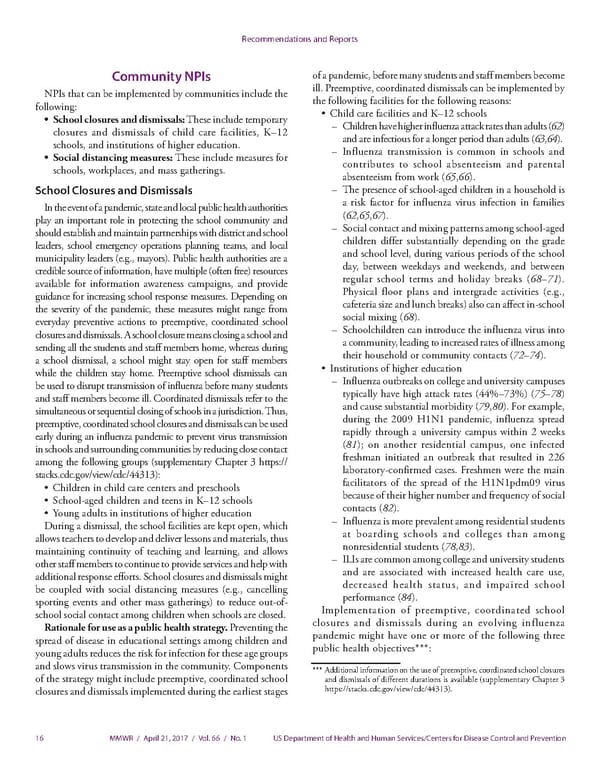Recommendations and Reports Community NPIs of a pandemic, before many students and staff members become NPIs that can be implemented by communities include the ill. Preemptive, coordinated dismissals can be implemented by following: the following facilities for the following reasons: • School closures and dismissals: These include temporary • Child care facilities and K–12 schools closures and dismissals of child care facilities, K–12 – Children have higher influenza attack rates than adults (62) schools, and institutions of higher education. and are infectious for a longer period than adults (63,64). • Social distancing measures: These include measures for – Influenza transmission is common in schools and schools, workplaces, and mass gatherings. contributes to school absenteeism and parental absenteeism from work (65,66). School Closures and Dismissals – The presence of school-aged children in a household is In the event of a pandemic, state and local public health authorities a risk factor for influenza virus infection in families play an important role in protecting the school community and (62,65,67). should establish and maintain partnerships with district and school – Social contact and mixing patterns among school-aged leaders, school emergency operations planning teams, and local children differ substantially depending on the grade municipality leaders (e.g., mayors). Public health authorities are a and school level, during various periods of the school credible source of information, have multiple (often free) resources day, between weekdays and weekends, and between available for information awareness campaigns, and provide regular school terms and holiday breaks (68–71). guidance for increasing school response measures. Depending on Physical floor plans and intergrade activities (e.g., the severity of the pandemic, these measures might range from cafeteria size and lunch breaks) also can affect in-school everyday preventive actions to preemptive, coordinated school social mixing (68). closures and dismissals. A school closure means closing a school and – Schoolchildren can introduce the influenza virus into sending all the students and staff members home, whereas during a community, leading to increased rates of illness among a school dismissal, a school might stay open for staff members their household or community contacts (72–74). while the children stay home. Preemptive school dismissals can • Institutions of higher education be used to disrupt transmission of influenza before many students – Influenza outbreaks on college and university campuses and staff members become ill. Coordinated dismissals refer to the typically have high attack rates (44%–73%) (75–78) simultaneous or sequential closing of schools in a jurisdiction. Thus, and cause substantial morbidity (79,80). For example, preemptive, coordinated school closures and dismissals can be used during the 2009 H1N1 pandemic, influenza spread early during an influenza pandemic to prevent virus transmission rapidly through a university campus within 2 weeks in schools and surrounding communities by reducing close contact (81); on another residential campus, one infected among the following groups (supplementary Chapter 3 https:// freshman initiated an outbreak that resulted in 226 stacks.cdc.gov/view/cdc/44313): laboratory-confirmed cases. Freshmen were the main • Children in child care centers and preschools facilitators of the spread of the H1N1pdm09 virus • School-aged children and teens in K–12 schools because of their higher number and frequency of social • Young adults in institutions of higher education contacts (82). During a dismissal, the school facilities are kept open, which – Influenza is more prevalent among residential students allows teachers to develop and deliver lessons and materials, thus at boarding schools and colleges than among maintaining continuity of teaching and learning, and allows nonresidential students (78,83). other staff members to continue to provide services and help with – ILIs are common among college and university students additional response efforts. School closures and dismissals might and are associated with increased health care use, be coupled with social distancing measures (e.g., cancelling decreased health status, and impaired school sporting events and other mass gatherings) to reduce out-of- performance (84). school social contact among children when schools are closed. Implementation of preemptive, coordinated school Rationale for use as a public health strategy. Preventing the closures and dismissals during an evolving influenza spread of disease in educational settings among children and pandemic might have one or more of the following three young adults reduces the risk for infection for these age groups public health objectives***: and slows virus transmission in the community. Components *** Additional information on the use of preemptive, coordinated school closures of the strategy might include preemptive, coordinated school and dismissals of different durations is available (supplementary Chapter 3 closures and dismissals implemented during the earliest stages https://stacks.cdc.gov/view/cdc/44313). 16 MMWR / April 21, 2017 / Vol. 66 / No. 1 US Department of Health and Human Services/Centers for Disease Control and Prevention
 Community Mitigation Guidelines to Prevent Pandemic Influenza Page 17 Page 19
Community Mitigation Guidelines to Prevent Pandemic Influenza Page 17 Page 19